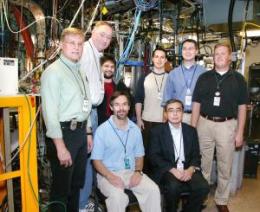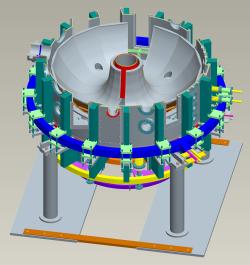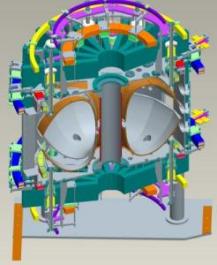The Lithium Tokamak Experiment

Members of the LTX team (standing from left) Tom Kozub, John Timberlake, Jef Spaleta, Tim Gray, Vlad Soukhanovskii, and Craig Priniski; (seated from left) are Dick Majeski and Bob Kaita.
The Lithium Tokamak Experiment (LTX), and its predecessor, the Current Drive Experiment-Upgrade (CDX-U), are devices dedicated to the study of liquid lithium as a plasma-facing component (PFC). One of the attractive features of a liquid lithium PFC is that it virtually eliminates recycling, or the re-introduction of cold gas back into the plasma from the vacuum chamber walls. This is because lithium has a high chemical reactivity with atomic hydrogen, which is then retained in the PFC. Flowing liquid lithium can also potentially handle the high power densities expected on fusion reactor walls. In addition, lithium has a low Z, so radiation losses should be reduced if there is any sputtering from the PFC.
All major tokamaks have obtained their best performance under low recycling conditions. If a fully non-recycling wall can be achieved, theory predicts that the basic nature of magnetic confinement will be changed. The temperature and density profiles, and plasma current distributions, would potentially eliminate deleterious plasma instabilities. Furthermore, the transport mechanisms causing the loss of energy and particles would be reduced, and plasmas with higher energy confinement could result.
As the first test of large area liquid lithium PFC, CDX-U had a toroidal tray on the bottom of the vacuum chamber to contain the lithium. Even with this partial non-recycling PFC, major improvements in plasma performance were obtained. Impurities were reduced, and a dramatic improvement in energy confinement was observed. To achieve more a complete non-recycling PFC, the CDX-U vacuum vessel was disassembled for the installation of a heated inner shell inside it. This was a major step for the conversion of CDX-U to LTX.
The shell was fabricated out of 3/8” copper sheets, which had a stainless steel liner explosively bonded to it. The stainless steel plasma-facing surface of the inner LTX shell will be coated with lithium between shots, using an electron beam evaporator. By keeping the shell temperature above the melting point of lithium, 90% of the LTX PFC area (~5 m2) will consist of non-recycling liquid lithium.



